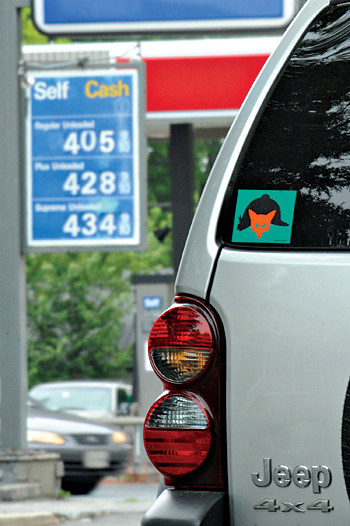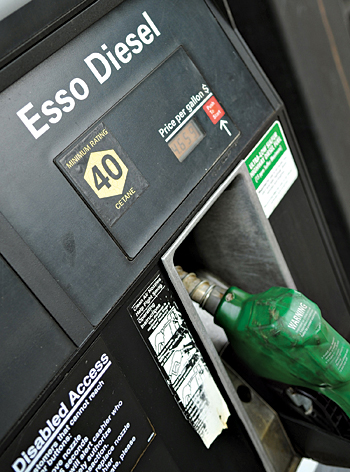With fuel prices rising daily, equine professionals from coast to coast are being forced to find new ways to absorb the cost. If you’re dreading each trip to the gas station, you’re certainly not alone.
 “The majority of our 40 tractor trailers are very new, which helps with fuel efficiency. We’ve kept the same rates but added a little bit of a surcharge. But people understand when they see prices go up to [more than $4] per gallon for diesel.
“The majority of our 40 tractor trailers are very new, which helps with fuel efficiency. We’ve kept the same rates but added a little bit of a surcharge. But people understand when they see prices go up to [more than $4] per gallon for diesel.
“We’re trying not to let the fuel prices affect our pricing, so we combine loads and try to move dates around. It just takes a little bit more planning now, that’s all. We’ve actually put on more people and more help. We’re just spending that much more time planning the loads and making sure everyone’s comfortable and safe.”
—Lindsey Anderson
Brook Ledge Horse Transportation
Oley, Pa., Lexington, Ky., and Ocala, Fla.
“Years ago when the gas crunch first hit, we tried to institute a fuel surcharge and nobody wanted to pay it. We’ve just had to raise prices. I’ll be honest–I’m scared. I pride myself on service, and we do the extras that it takes to keep a customer. So I’m crossing my fingers and hoping that if I have to raise my prices 10, 15, maybe even 20 percent, people will stay with us. But loyalty isn’t as strong as it used to be.
“We don’t do too many two- or three-horse loads. You can’t do that anymore because you’re losing money. From the Northeast to Florida is 1,200 miles. It used be $300 to $500 to fill up, and now it’s [more than] $1,000, and that’s just one way.
“It’s hurting everybody. Hopefully the people will realize it. The extra cost to fill up their Mercedes is an exponential increase for us.”
—Jeff Nolte
B.D. Horse Transportation, Inc.
Blue Bell, Pa.
“We have three vets at our practice, and we cover five counties in Northern Florida and parts of Southern Georgia. We all drive trucks, and we put 40,000 to 50,000 miles on each per year. My wife drives a Toyota Prius, which gets 51 miles to the gallon, but in my truck I’m getting about 20 miles to the gallon, if I’m lucky.
“We have a giant map on the office wall, and we try and get everybody organized, because our radius is about 40 miles. So if we’re going to St. Simon’s Island (Ga.) or something, we’ll try to get everyone there together and so we can go and spend most of the day. But emergencies can really mess up a day. They have to get billed the full mileage fee.
ADVERTISEMENT
“Our trip fee has always been a standard of like $1 a mile, but you just can’t do it like that anymore. We’ve had to increase ours by about 25 percent. We get a lot more of the ‘While you’re here, Doc…’ than we used to.
—Alan Weldon, DVM
Jacksonville Equine Associates
Jacksonville, Fla.
“We’re flying the same amount of flights, but the consumers are paying a fuel surcharge of about $1.25 per kilo. Lufthansa sets their fuel price index about every month, and everybody goes by it. We started adding our fuel surcharge about eight months ago, when we just couldn’t absorb the extra costs.
“It’s an Olympic year, and a lot of the horses are going back and forth, and, unfortunately, it’s going to cost them a lot of money, with the dollar so weak against the Euro. But that’s the nature of the beast.
“It really has not affected my business, as most understand the cost is directly due to fuel prices. All the airlines are adding $25 or $30 per ticket for a human being, and that’s only 200 pounds or so. So I think $600 per horse is very reasonable for a trip across the pond.”
—Tim Dutta
The Dutta Corporation
North Salem, N.Y.

“I haven’t really changed the prices [of my merchandise]. Since I have a lot of European merchandise, the Euro going up and up is one thing that definitely affects my pricing, but not really the price of transportation.
“I don’t really think [fuel prices have] affected us too much, but I’m also not paying what some tack shops are, with the big semi-trailers. One of my competitors said he paid $4.85 a gallon the other day.
“My trailer is 48 feet long, pulled by a one-ton [diesel] pickup. The transportation of my rig hasn’t had much impact. More than anything, I see a difference in business in general. I feel like there’s definitely a change in our economy in general and it’s affecting our clientele.”
—Lisa Sweet
Ayora Saddlery
Santa Ynez, Calif.
“I’ve been doing this 32 years, and whereas I was spending $100 a week two years ago, now my 2007 Chevy Diesel Heavy Duty is looking to average more than $300 a week in fuel. So it’s not good. I’ve seen the cost of my supplies increase, so I’ve raised my prices up to about 20 percent, and I have to charge a call fee.
“I’ve cut back on some of my travel, and I’m using my motorcycle. If I can schedule a day of trims, I’ll take it–it costs about $15 a day.
ADVERTISEMENT
“My clients are very understanding. You try to be fair about spreading it out and don’t gouge the ones that have the longest driveways. You’ve got to have some empathy for your clients, so you eat it. It’s just a little less money that you’re going to take home and save. Period.”
—Jack Millman
Jack Millman Farrier Services
Worthington, Mass.
“Our quoted price on diesel last May was $2.75 for road fuel, and we’re looking at almost $4.60 today, so that’s a substantial difference. And that’s the simple math. What’s not so simple to figure up is the fact that the oil that has to go in the engine is costing more. Tires have gone up almost $100 apiece. Our parts provider just sent us another fuel charge for delivery on parts this morning. It’s just on and on down the line.
“There’s supposed to be a decrease in hay acreage this year, and the places where hay is going to increase in acreage are going to be really almost inaccessible, like South Dakota and Wyoming. There may only be one truck a week up there.
“I sell my hay for whatever price I dictate it has to be for us to still make it. You just have to pass it on. It’s the only thing you can do. The majority of our clients have always been the people that could afford our services. But the backyard horse owner, who makes $15,000 a year working at the feed store, he’s hurting bad. It’s going to be really bad this summer. Bad like people don’t know.”
—Calvin Howard
Production Acres Hay Company
Lancing, Tenn.
“Everybody [we teach] comes to us. But there are some riding teachers who have to add a fuel surcharge [to travel]. We live fairly far from our barn, so every time we go back and forth, it’s about $10 or $15. And because we have such great distances to drive, we have to really think twice about going to the East or West Coast to compete now.
“The owner of our farm is wanting to raise the board all the time because the cost of hay, grain and shavings is going up because of the cost of shipping them in. We have complaints, but people have been absorbing it so far.
“At this point it’s an annoyance and it cuts into profits so to speak, and everything is a bit more expensive, but I don’t think it’s stopped the upper-middle class horse people. But, obviously, everybody is pulling back. Really, it’s the economy in general. People are saying, ‘Let’s see what happens after the election,’ versus, ‘I’m going to go and buy something now.’ It’s a little bit of a worry, but it’s hard to say. This country’s pretty resilient. Our country’s always bounced back, so we’ll see.”
—Grant Schniedman
Dressage Trainer, Westmanton Stables LLC
Castle Rock, Colo.
Kat Netzler






